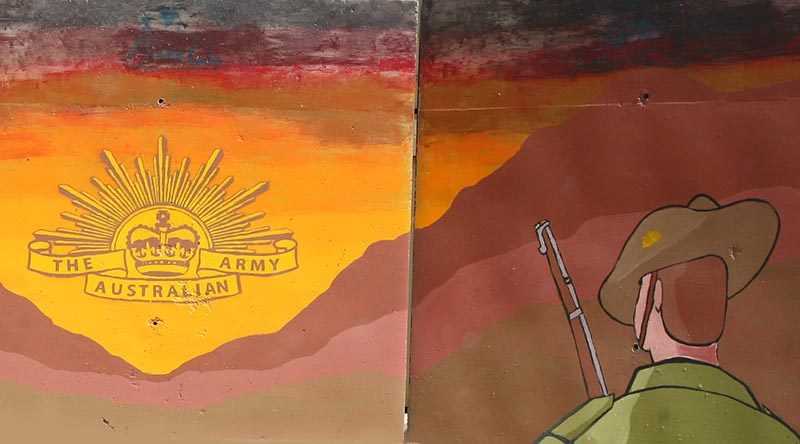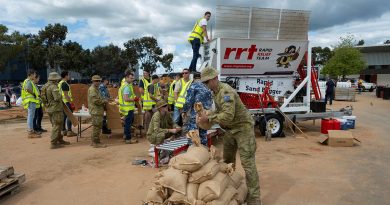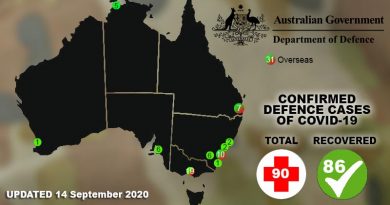Aussie veterans find new verve for life through art therapy
Share the post "Aussie veterans find new verve for life through art therapy"

Aussie veterans could be afforded a new lease on life as ground-breaking research from the University of South Australia shows how art therapy is transforming the wellbeing and mental health of service men and women diagnosed with post-traumatic stress disorder.
FILE PHOTO (2012): T-wall art at Tarin Kot, Afghanistan.
Funded by The Hospital Research Foundation’s Group charity The Road Home, the Australian-first study is examining how art therapy can treat PTSD among veterans, defence and emergency services personnel.
It’s a critical study given the growing cases of PTSD in the community: in the past five years, 46 per cent of defence force veterans have met the diagnostic criteria for a mental disorder, and one in three emergency services personnel have experienced high or very high psychological distress and probable PTSD.
Lead researcher and PhD candidate, UniSA’s Holly Bowen-Salter, says the research hopes to provide valuable evidence to support much-needed funding for art therapy in Australia.
“Australia’s defence and emergency service personnel are exposed to a high number of traumatic events which, untreated, can result in severe emotional distress or post-traumatic stress symptoms,” Bowen-Salter says.
“Leading into Anzac Day amid Covid-19 – and in the wake of Australia’s devastating bushfire season – supporting our critical defence and emergency services personnel is on everyone’s minds.
“Traditional talk therapies are often prescribed to treat PTSD, yet with a massive 70 per cent of military personnel retaining a PTSD diagnosis after such treatments, an alternative approach is needed.
“Art therapy is an alternative to traditional talk therapies, combining counselling and visual arts to enable a participant to address long-standing attitudes, thoughts, and behaviours. But unlike talk therapies, the focus is on the art, not the need to express and revisit their traumatic experiences.
“In the US and UK, art therapy is a popular and successful mental health practice, attracting millions of dollars to support implementation and research. Yet in Australia, it is still in very early phases and needs increased legislative and regulatory practices to establish it as a credible and valuable intervention – and this is where our research comes in.”
Using in-depth interviews, the research has already shown that art therapy can deliver improvements in mood, outlook, behaviours, as well as confidence, personal relationships and, importantly, a sense of self-awareness – all essential for long-term understanding and healing.
The team is also calculating a social return on investment (SROI) – how many dollars of social value is returned for every dollar invested into the program – to further support the need for formal funding.
The Road Home’s Resident Art Therapist, Karin Foxwell, says Covid-19 has seen her 90-minute art therapy sessions transition online to ensure her patients maintain momentum and progress while practising social distancing.
“Isolation is always a red flag for those in mental distress, so it’s incredibly important that we maintain connection with all our patients,” Foxwell says.
“Art therapy – whether online or face-to-face – allows traumatic material to be externalised through imagery where the participant can view the content with a measure of emotional distance. This creates an opportunity for the creation of a new and coherent narrative in a safe way.
“Luckily, we’ve found online art therapy not to be too far removed from an in-person consult – so, instead of discussing an artwork face-to face, a patient simply holds it up to the camera, and we decipher it from there.”
CEO of The Hospital Research Foundation (THRF) Group Paul Flynn says they are working hard to keep these services running for veterans and emergency services personnel as best they can under these unprecedented circumstances.
“It is important Art Therapy participants are still receiving these beneficial sessions and given the current situation, online sessions are proving to be quite successful. This way the participants feel like we are still there for them especially during these times,” Flynn says.
The best evidence of art therapy to treat PTSD among defence and emergency services personnel is through the words of the participants themselves, who broadly report that art therapy gets to the heart of the trauma, healing the wounds, not band-aiding the issues.
Quotes from at therapy participants include:
“Art therapy has given me a way of accessing and understanding my trauma. It has enabled me to express it in a new visual language, so I can actually acknowledge it, see it and work with it. Before this, I had lots of things going on for which I had no language.” – ADF veteran.
“You recognise something that’s been going on which is negative in yourself, and you can see it by using [art therapy]. You’re able to explain it to yourself and then you understand it. It’s like turning the switch on and clicking.” – ADF veteran.
“I think I’m in a better place than when I initially started. I remember feeling absolutely desperate to find something to help me… I was at a stage of just bubbling over with emotions. [Since starting Art Therapy] some of the nightmares that I’ve had have been less obvious or some have even disappeared. General happiness has improved. A little bit more in control of the emotions and my outbursts, my reactions to family members and things… I seem to be a little bit more of my old self.” -First Responder.
“If I was to add up all the money I’ve spent on psychologists and counsellors and all these other things over the years, it would run into the tens of thousands of dollars, if not more. Coming into see [the art therapist], just once a week has made a massive difference – I’m now able to put back into society and do my own voluntary work within the veterans’ community. I’d say it’s a no brainer, it just has to be continued to be funded.” -ADF veteran.
“This [art therapy] kind of goes to different place like beliefs about yourself. I talk while I’m sort of splashing the paint around … and I find myself wondering about things in my life… I can be more of a force in shaping where I want to go.” – ADF veteran.
.
.
.
.
.
.

.
.
Share the post "Aussie veterans find new verve for life through art therapy"





